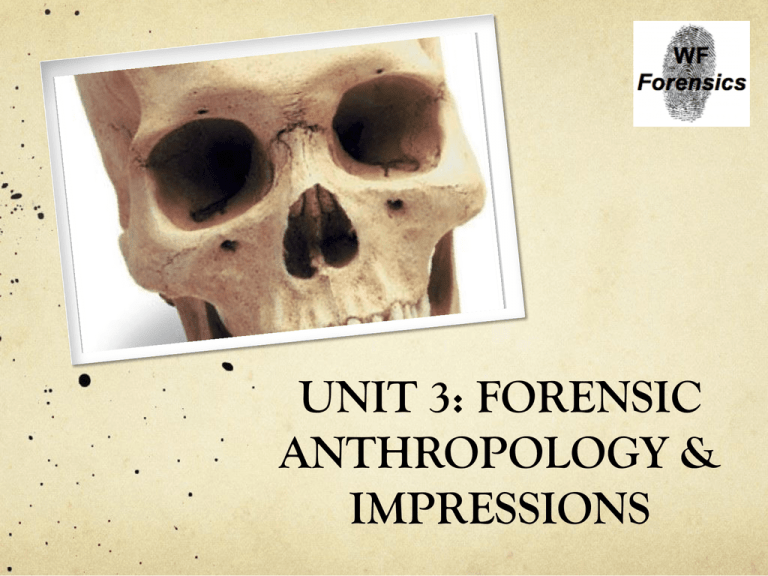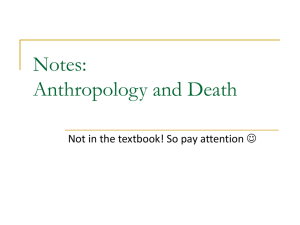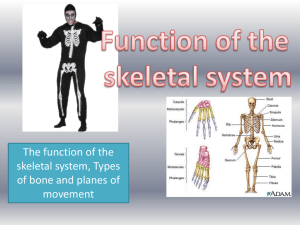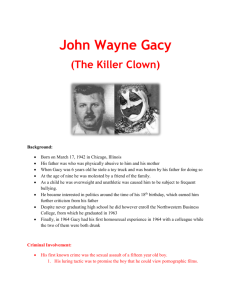
UNIT 3: FORENSIC
ANTHROPOLOGY &
IMPRESSIONS
Objective: Identifying
Male vs Female
DO NOW: What differences in bones
do you think exist between males and
females?
If you missed the quiz on Friday see
me now
What is Forensic
Anthropology?
The field of study that deals with
the analysis of human skeletal
remains resulting from unexplained
deaths
Development of Bone
Bones begin as cartilage then harden
to form bone (ossification)
206 Bones in Human Body
Joint- location where bones meet
Cartilage- found at ends of bones
and protect bone
Ligaments- connects bones to bones
Tendons- connect muscle to bone
Basic Bones
SKULL
Contains bones of the
cranium and face
Basic Bones
HUMERUS
Upper arm bone
ULNA & RADIUS
Forearm bones
Basic Bones
FEMUR
Thigh bone
TIBIA & FIBULA
Lower leg bones
Basic Bones - Pelvis
SACRUM
Triangular
bone at the
end of the
spine
COXAL
Hip Bones
Male or Female?
Female- Skeleton is much smoother
Male Skeleton is thicker, rougher, bumpier
Muscles are more developed so
where they attach need to be
stronger
ex. knee
M vs F: Orbits
M: square
Male
F: round
Female
M vs F: The Jaw
M: square – 90 deg
F: round, V-shape - >90 deg
Male
Female
M vs F: Frontal Bone
M: low and sloping
F: high and rounded
Male
Female
M vs F: Occipital bone
(back of skull)
M: bump present
Male
F: bump absent
Female
M vs F: Shape of Pelvic
Cavity
M: Heart shaped, narrow
F: Oval shaped, wider
M vs F: Subpubic Angle
M: 50 – 82 deg
MALE
F: 90 deg
FEMALE
M vs F: Sacrum
M: long, narrow, curves inward
F: short, broad, curves outward
MALE
FEMALE
Activity
Complete Identifying male or
female activity
Closure Q’s from Activity:
Case #1:
Round eye orbits, Subpubic angle of 103°
Case #2:
Narrow pelvis, Sloping forehead
Case #3:
Smooth skull, Sacrum curves outward
Objective: Determine
Gender of Bones
DO NOW: What is the shape of the
pelvic cavity in females and why?
Complete the lab male vs female
skeleton
Objective: Determining Age
DO NOW: Why are male bones
rougher than females?
Determining Age
Can determine age by looking at
certain bones for cartilage still
remaining
Age: Infant or Not?
Age: Sutures are where
skull bones connect
Lamboidal suture (back of head) – 30 yrs
Coronal suture (front of head) – 50 yrs
Age- Epiphysis
•
The presence of a line that marks where
cartilage is replaced by bone
•
The age of completion varies for each bone
Young (unfused)
older (fused)
even older (fused)
Age: Teeth
Have deciduous teeth fallen out?
Have wisdom teeth erupted?
Age
When the head of a long bone has
fused with the shaft it can help
determine age
Example:
Humerus head fused: 4 – 6 yrs
Humerus head fused to shaft: 18 - 20
Case Study
Complete the snaggletooth killer
case study
Objective: Video case study
DO NOW: If the skull is completely
fused what does that indicate about the
age of the individual?
Objective: video case study
www.mrpalermo.com (first 48)
Complete the case review sheet
Objective: Determine
Height of Victim
DO NOW: How can teeth be used
to determine age?
****Hand in snaggletooth killer case
study
Height
Measuring bones can help to
approximate height
Gender and race should be
considered if known
Determining Height
Female
tibia (cm) x 2.53 + 72.57 = height (cm)
radius (cm) x 3.87 + 73.50 = height (cm)
Male
tibia (cm) x 2.39 + 81.68 = height (cm)
radius (cm) x 3.65 + 80.40 = height (cm)
A 41.3 cm Caucasoid male tibia was found in a wooded area.
How tall was the this person?
41.3 cm x 2.39 + 81.68 = 180 cm (5’-11”)
Lab:
Complete Lab on Determining Height
Work in groups of 2 or 3
To convert cm to feet:
Multiply by 2.54 then divide by 12
Lab: Determining Height
Do Now: What is the largest bone
in the human body?
http://www.youtube.com/watch?v=c
8IHPq9VgWI
Finish Lab Today
Objective: Facial
Reconstruction
DO NOW: What other useful
things can be determined by bones
besides age, height and sex?
Race (ancestry)
Can be difficult due to interracial
people so not as significant as other
factors
Best determined with skull and
femur
Three categories are Caucasian,
African, and Asian
Mongoloid/Asian Skull
Caucasian/European Skull
Negroid/African Skull
Facial Reconstruction
Size and shape of bones vary in
people
Facial markers are placed on the skull
and clay is applied to follow the
height of the markers
Today computer programs can do
this
Programs can adjust features and age a person
Facial Reconstruction
Facial Reconstruction
Facial Reconstruction
http://www.youtube.com/watch?v=
VF1cVAb0J2Q
DNA Evidence
Bones contain little nuclear DNA
but do contain mitochondrial DNA
Can compare mitochondrial DNA
with living relatives on the mother's
side to identify bones
Skeletal Trauma Analysis
Forensic anthropologists determine if
damage to bones occurred before or after
death
Antimortem- before death
Perimortem- at or around time of death
Postmortem- after death
There are distinctions between
damage caused by weapons and
those created by the environment
after death
Antimortem damage
Perimortem damage
Ex. Sword wound
Postmortem Damage
http://www.youtube.com/watch?v=
FGcN9_Gd5zQ
Types of Trauma
Sharp-force trauma, blunt force trauma, and
gunshot wounds have distinct patterns
Sharp force trauma
Blunt force Trauma
Gunshot wound
The Body Farm
http://www.youtube.com/watch?v=qZmLo8qIx4
Objective: case study
John Wayne Gacy
Do Now: Can DNA be found in
bones?
Objective: case study
John Wayne Gacy
Complete case study on john wayne
gacy
Objective: Video Case
Study John Wayne Gacy
http://www.youtube.com/watch?v=
FPMHsaT88Sk
Closure Q’s
How many people did he kill?
Why was he called the killer clown?
Did he target a particular type of
victim? If so what type?










